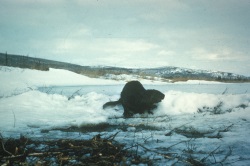
Image Courtesy US FWS
When temperatures dip below freezing and wind hurries on its way, we often find ourselves looking for another warm body to huddle near and share heat. Children snuggle into laps and dogs lean close.
Many animals huddle to stave off the cold. Species that are strong individualists in balmy seasons seek warmth from a group when temperatures drop. Many non-colonial rodents will share a den come winter.
[Kevin Colver recording: Songbirds of the Southwest Canyon Country]
Pygmy nuthatches jam themselves tightly together into tree cavities as do flying squirrels. Through the winter, worker honeybees huddle tightly around a central patch of wax comb where developing larvae are growing. The larvae die if temperatures drop below 83 degrees, so a living blanket of worker bees shivers to generate the heat equivalent to a 40 watt incandescent bulb.
An animal loses heat in direct proportion to its surface area. By huddling together, each animal reduces its exposed surface area. This in turn allows them to reduce their metabolic rate and so conserve energy at a time when food can be scarce or inaccessible.
Nests or dens occupied by numerous individuals can be much warmer than ambient. A snow covered lodge with at least 2 beaver occupants can be as much as 35 degrees warmer than the outside air temperature. A study of taiga voles showed that underground nests containing 5 to 10 residents remained 7 to 12 degrees warmer than the surrounding soil and up to 25 degrees warmer than the air above. Individuals take turns going out to forage so their nest remains toasty.
Living in close proximity does have its problems. Disease and parasites are readily transmitted in tight quarters. Local food competition could potentially lead to hunger or starvation. Predators may more easily discover prey in groups. But for many animals, the advantages of huddling for warmth far outweigh the risks during our chilly winter months.
This is Linda Kervin for Bridgerland Audubon Society.
Credits:
Photos: Courtesy US FWS
Audio: Courtesy Kevin Colver, https://wildstore.wildsanctuary.com/collections/special-collections, https://wildstore.wildsanctuary.com/collections/special-collections
Text: Linda Kervin, Bridgerland Audubon Society
Additional Reading:
Life in the Cold: An Introduction to Winter Ecology. Peter Marchand. 1991, University Press of New England. https://www.amazon.com/Life-Cold-Introduction-Winter-Ecology/dp/0874517850
Lives of North American Birds. Kenn Kaufman. 1996, Houghton Mifflin Company. https://www.amazon.com/American-Peterson-Natural-History-Companions/dp/0395770173
The Birder’s Handbook. Paul R. Ehrlich, David S. Dobkin and Darryl Wheye. 1988, Simon & Schuster, Inc. https://www.amazon.com/Birders-Handbook-American-including-Regularly/dp/1435277589
